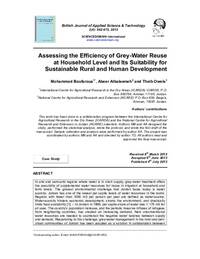Assessing the Efficiency of Grey-Water Reuse at Household Level and Its Suitability for Sustainable Rural and Human Development

Authors:
In arid and semi-arid regions where water is in short supply, grey-water treatment offers the possibility of supplemental water resources for reuse in irrigation at household and farm levels. The gravest environmental challenge that Jordan faces today is water scarcity. Jordan has one of the lowest per capita levels of water resources in the world. Regions with fewer than 1000 m3 per person per year are defined as water-scarce. Water-scarcity hinders economic development, strains the environment, and drastically limits food availability [1]. – In Jordan in 1996; per capita share of water was < 175 m3 for all uses. The country’s population increase, and the periodic massive influxes of refugees from neighboring countries, has created an increasing demand. New unconventional water resources are needed to counteract the negative water balance between supply and demand. Responding to this challenge, grey-water management in the rural and peri-urban communities of Jordan has been adopted as a solution in collaboration between the International Centre for Agricultural Research in the Dry Areas and the National Centre for Agricultural Research and Extension. The project adopted participatory approach with all stakeholders to achieve project’s objectives. Several meetings were held with community members and Community Based Organizations in the project area. Furthermore, community involvement and gender consideration are important factors to achieve sustainability in project implementation. The general goal of the project is to improve the quality of life and well-being for rural Jordanians through adopting appropriate grey-water treatment units for the purpose of crop production and income generation. A monitoring program was implemented in August 2010 in six locations. Of these locations, three used volcanic tuff material as the filtration media and the others used white gravel. The monitoring program included collection of water, soil and plant samples. The water sample analyses showed that using medium-sized volcanic tuff as a filtration media is more effective than using medium-sized gravel. There was a 73% reduction in the biological oxygen demand when using volcanic tuff and a 49% reduction when using gravel. Moreover, grey-water quality after treatment was within the permissible limits of the Jordanian standards for its use in irrigation. The results of plant leave quality and soil analysis being irrigated with grey-water showed that grey-water has no adverse effects on plant quality and soil properties. However, leaching of soil with fresh water from time to time is recommended. Furthermore, community involvement and gender consideration are important factors to achieve sustainability in project implementation.
